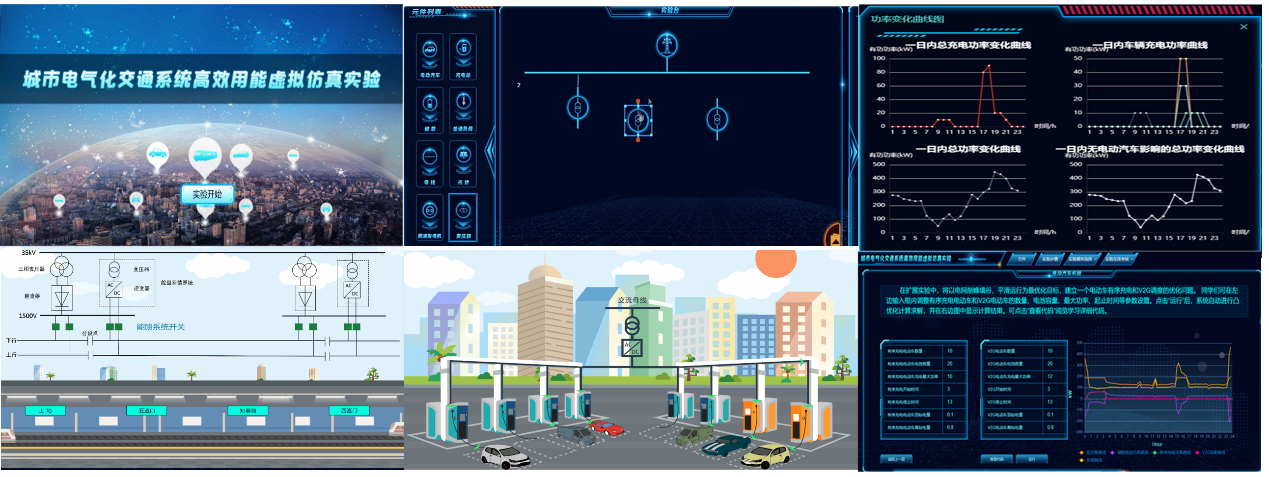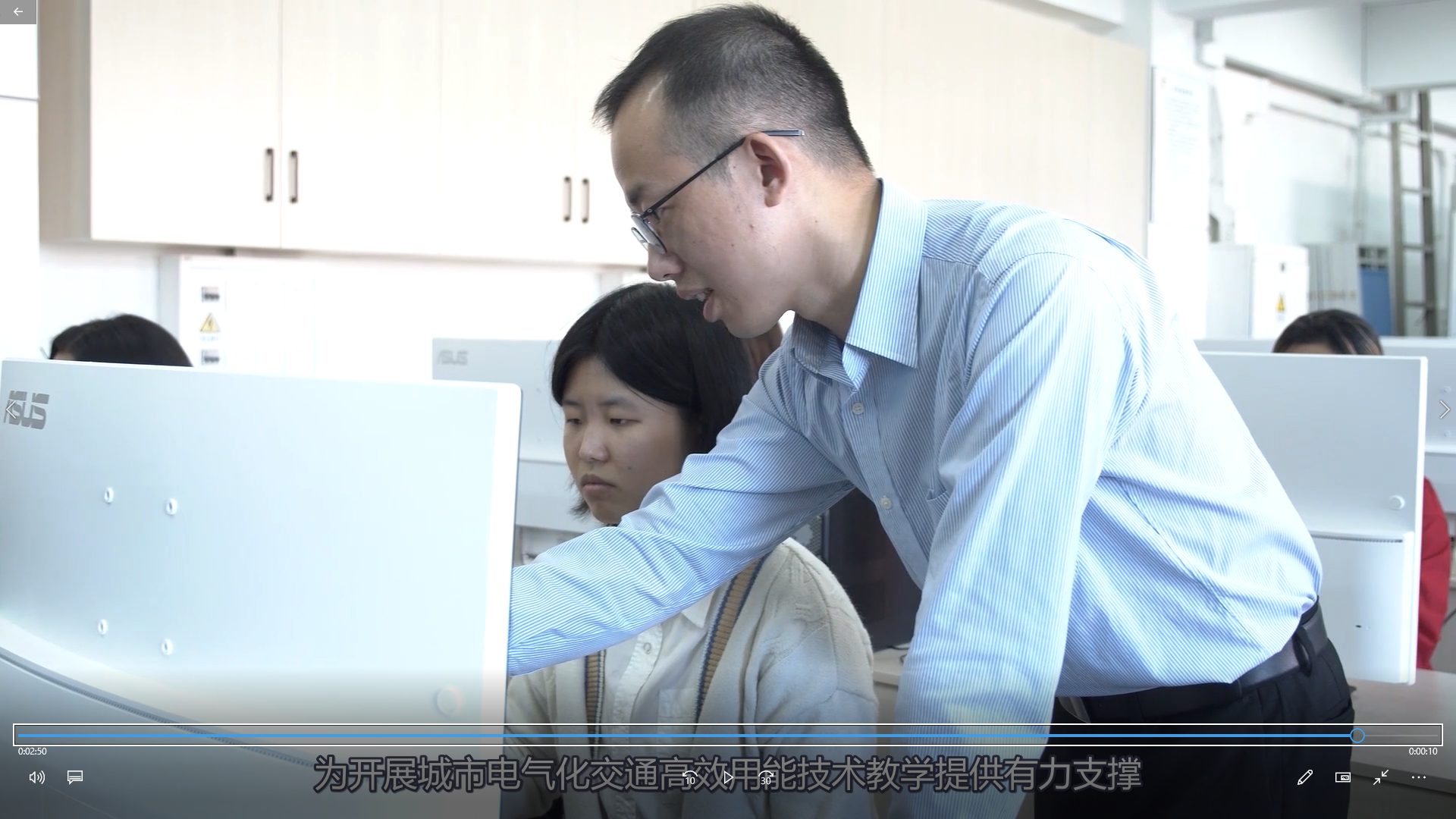Course Introduction
Against the background of the national "dual carbon" goals and the Ministry of Education's "new engineering" construction, Professor Xu Yin from the School of Electrical Engineering, Beijing Jiaotong University, has developed the course "Virtual Simulation Experiment on Efficient Energy Utilization of Urban Electrified Transportation Systems" by integrating talent training needs with the university's characteristic disciplines. The course has been recognized as a National First-Class Undergraduate Course (virtual simulation category) in the second batch by the Ministry of Education.

The experimental content of the course involves the interdisciplinary field of electrical engineering and transportation, covering the efficient energy utilization of rail transit and large-scale orderly charging of electric vehicles in urban distribution networks. The experiment design adopts cutting-edge virtual simulation technology, which not only truly restores the energy utilization scenarios of electrified transportation systems but also provides a modular electrical-transportation distribution network system that can be flexibly built in a "building block" manner. This gives students space for exploration and trial-and-error, ensures the challenge and advanced nature of the experimental content, and cultivates students' innovative and critical thinking abilities. In the experimental project content, by introducing the concepts and connotations of the "dual carbon" goals and social sustainable development, students understand the role and impact of electrified transportation systems. At the same time, combined with the rapid development of electrified transportation, students perceive and understand the rapid changes in the motherland, integrating their patriotic enthusiasm, professional interest and diligent learning.

Background of Course Construction
Under the guidance of the "National Strategy for Building a Transport Power" and the "new infrastructure" policy, urban electrified transportation has developed vigorously. Although it has alleviated the energy crisis to a certain extent, the energy consumption generated by electrified transportation loads has been continuously increasing. To achieve China's proposed "carbon peaking and carbon neutrality" goals, how to improve the energy efficiency of electrified transportation systems and promote the decarbonization of energy consumption has become a major challenge for urban electrified transportation systems. As a training base for scientific and technological innovative talents, universities should timely carry out teaching related to efficient energy utilization technologies of urban electrified transportation systems to help improve the energy efficiency of urban electrified transportation systems and cultivate compound "new engineering" talents with high-level professional knowledge and low-carbon environmental protection concepts.
However, urban electrified transportation systems have the characteristics of "high voltage, high speed, large scale, and high cost", leading to difficulties in on-site teaching implementation. Small-scale physical platforms have limited reference value, which seriously restricts the development of teaching related to efficient energy utilization of urban electrified transportation systems. Specifically:
First, the power supply voltage of urban electrified transportation systems is high, and the operating speed of vehicles is fast, so there are potential safety hazards in on-site teaching. Urban rail transit systems (subways, urban rails, etc.) and electric vehicle charging facilities include many high-voltage, high-temperature, and high-speed rotating equipment, which pose potential safety hazards such as electric shock, scalding, and scratching to personnel during on-site teaching.
Second, the efficient energy utilization experiment of urban electrified transportation systems involves operations such as the switching of rail transit energy feedback systems and the setting of electric vehicle charging, which require the permission of power and transportation departments. The experiment arrangement is difficult, and the consequences of incorrect operation are serious. Rail transit systems and electric vehicle charging systems are key urban infrastructure. On-site experiments generally require the permission of power and transportation departments, and students are usually not allowed to carry out experiments due to safety management requirements. Incorrect operation may endanger passenger safety and cause equipment damage.
Third, urban electrified transportation systems are large in scale, and building physical platforms requires a long cycle and high cost. Urban electrified transportation systems are integrated power and transportation systems, and it is difficult to have an overall grasp even on-site. Building small-scale platforms is difficult to reflect the actual operating characteristics of the system, and their teaching support value is limited. Building large-scale physical platforms requires a large area, complex construction, long construction cycle, and high cost, which is difficult for most universities to achieve.
To solve the above problems, this experimental project integrates the two disciplines of power and transportation, and moves the engineering scenarios of efficient energy utilization of urban electrified transportation systems into the classroom through virtual simulation technology. This realizes the deep integration of virtual simulation experiments and theoretical courses, breaks the constraints of time and space, and breaks the barrier between classroom and practice. It enables students to fully understand the content that is difficult to carry out on-site experiments, such as rail transit energy feedback utilization and orderly charging of electric vehicles, and provides a platform for students to design, analyze, expand and innovate.
First, the experiment highly restores the energy utilization scenarios of urban electrified transportation systems. It adopts human-computer interaction technology to provide students with independent design space for system topology and parameters. The online real-time simulation algorithm integrated in the background meets the needs of students for repeated trial-and-error debugging, which helps to improve teaching effects. The experiment conducts a highly realistic simulation of the inaccessible actual scene of urban electrified transportation systems, and intuitively presents the unfamiliar and abstract energy utilization scenarios of urban rail transit systems in the form of dynamic diagrams and simulation results, solving the problem of "difficulty in on-site teaching implementation and limited teaching reference value of small-scale physical platforms". During the experiment, it creates a multi-lateral interactive teaching environment for students. Students can independently design the topology and equipment parameters of urban rail transit systems, correct errors in a timely manner through platform feedback, and answer questions through online interaction between students and teachers. The online real-time simulation algorithm of urban electrified transportation systems integrated in the background provides students with conditions for multi-parameter debugging and repeated experiments, enabling independent and innovative learning that is difficult to carry out in physical experiments, and cultivating top innovative talents for the research of efficient energy utilization technologies of urban electrified transportation systems.
Second, the experiment design process focuses on restoring real scenarios, with a strong sense of "immersion", which helps students establish a sense of ownership in the field of energy and transportation. In the rail transit system energy feedback experiment, students observe the energy utilization rate by setting the operation mode and time period of trains under different passenger flow conditions and switching the energy feedback system. In the electric vehicle orderly charging experiment, students design electric vehicle orderly charging strategies and analyze their impact on system safety and operating energy efficiency, guiding students to establish a rigorous and realistic engineering design concept.
Third, the experiment integrates professional basic knowledge of multiple industries such as power systems, rail transit, and electric vehicles, which can broaden students' horizons and improve their comprehensive quality. The research objects of this experiment include urban distribution networks, rail transit systems, and electric vehicle charging systems, involving technologies such as distribution network networking principles, working principles of rail transit systems and energy feedback systems, electric vehicle charging modes, and orderly charging strategies. It provides students with professional basic knowledge of multiple industries including power systems, rail transit, and electric vehicles, helping students quickly adapt to the working environment and carry out professional work as soon as possible after graduation.
-----------------------------------------------------------------------------------------------------------------------------


